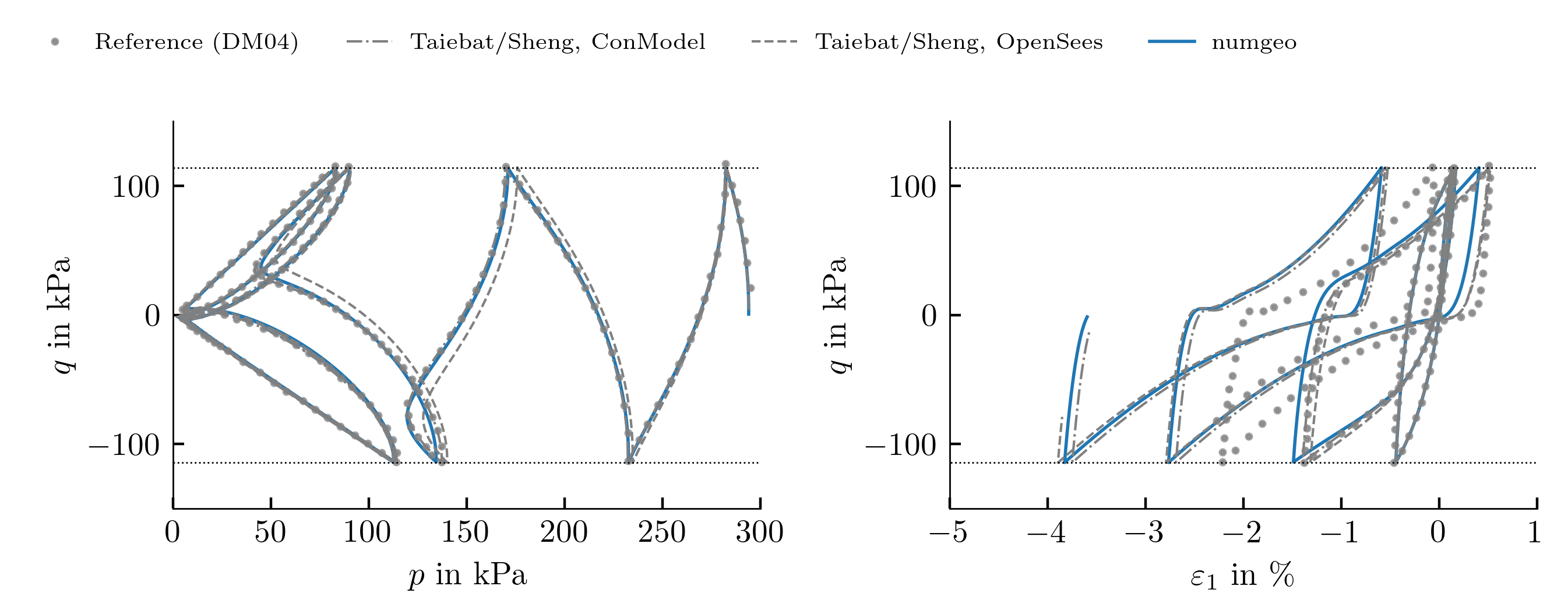Triaxial Test - Cyclic Consolidated Undrained
Table of contents
- Finite Element (FE) representation
- Validation of simulation approach
- Sample numgeo input file
- References
Finite Element (FE) representation
For the simulation of consolidated undrained (CU) cyclic triaxial tests we perform a so-called ‘‘single-element-simulation’’ with the FE program numgeo and by doing so enforce element test assumptions, i.e. a homogeneous distribution of stress/strain within the test sample. A schematic of the FE representation of the CU test is given below.

- An axisymmetric solid element with four nodes and linear shape functions for the displacement field is used. To enforce the incompressibility constrained from the undrained conditions ($tr(\dot{\boldsymbol{\varepsilon}})=0$), a locally undrained simulation is performed by assigning a Bulk modulus of pore water $K^w$. For any value of $K^w > 0$ the rate of pore water pressure is calculated as follows $\dot{p}^w = - K^w tr(\dot{\boldsymbol{\varepsilon}}) (1+e)/e$. The constitutive behaviour is governed by the effective stress $\boldsymbol{\sigma} = \boldsymbol{\sigma}^{tot}-p^w \boldsymbol{\delta}$, where $\boldsymbol{\sigma}^{tot}$ is the total stress and $\boldsymbol{\delta}$ is the Kronecker delta.
- In a first initial step, the initial conditions are applied, i.e. initial stress ($\sigma_1^0, \sigma_2^0$), initial void ratio $e_0$ or any other initial state variable required by the constitutive model to be calibrated
- In the second loading step, the loading is applied by prescribing either a periodic vertikal displacements $u_2$ of the top nodes or an additional periodic load $\Delta \sigma_2$ at the top surface of the element. The frequency of the cyclic loading is chosen as 1 Hz.
Validation of simulation approach
For the validation of the simulation approach, a comparison with the simulation results on Toyoura Sand with the SANISAND constitutive model reported in the original paper [1] is made. Mahdi Taiebat and Sheng Teng furthermore contributed simulation results of the same tests as in [1] such that a total of three implementations and simulation strategies could be used to benchmark the approach used in numgeo-ACT. The simulation results from Taiebat & Sheng were performed using either the finite element code OpenSees or their in-house constitutive model driver ConModel.

Sample numgeo input file
Example input file for the simulation of a stress controlled cyclic CU triaxial test using the Sanisand with numgeo are shown below.
**=~~=~~=~~=~~=~~=~~=~~=~~=~~=~~=~~=~~=~~=~~=~~=~~=~~=~~=~~=~~=~~=~~=~~=~~=~~=
** numgeo
** Copyright (C) 2022 Jan Machacek, Patrick Staubach
**=~~=~~=~~=~~=~~=~~=~~=~~=~~=~~=~~=~~=~~=~~=~~=~~=~~=~~=~~=~~=~~=~~=~~=~~=~~=
*Node
1, 0.0 , 0.00
2, 0.05, 0.00
3, 0.05, 0.1
4, 0.00, 0.10
*Nset, Nset=nall
1, 2, 3, 4, 5
*Nset, Nset=nleft
1, 4
*Nset, Nset=nright
2 , 3
*Nset, Nset=nbottom
1 , 2
*Nset, Nset=ntop
3 , 4
*Element, Type = U4-solid-ax
1, 1, 2, 3, 4
*Elset, Elset=eall
1
** ----------------------------------------
*Solid Section, elset = eall, material=soil
** ----------------------------------------
*Material, name = soil, phases = 1
*Mechanical = Sanisand-2
100,0.934,0.019,0.7,1.25,0.89,0.01,125
0.05,7.05,0.968,1.1,0.704,3.5,4,600
*Optional mechanical parameter
bulk_water, 2d6
*Density
2.65
** ----------------------------------------
*initial conditions, type=stress, geostatic
eall, 0.0, -294.0, 0.10, -294.0, 1.0, 1.0
*Initial conditions, type=state variables
eall, void_ratio, 0.808
** ----------------------------------------
*AMPLITUDE, NAME = LoadingRamp , TYPE = RAMP
0.0, 0.0, 1.0, 1.0
*AMPLITUDE, NAME = Sinus1Hz, TYPE=periodic
1,0.0,0.0,6.28
0,1
** ----------------------------------------
*STEP, name=step1, inc = 1
*GEOSTATIC
*BODY FORCE, instant
eall, GRAV, 0.0, 0, -1, 0
*DLOAD,instant
eall, P3, -294.0
*DLOAD,instant
eall, P2, -294.0
*BOUNDARY
nleft, u1, 0.0d0
nbottom, u2, 0.0d0
*END STEP
** ----------------------------------------
*STEP, name=step2, inc = 1000000, maxiter=32, miniter=1, no cutback
*Transient
0.001,4.,0.0001,0.001
*BODY FORCE, instant
eall, GRAV, 0, 0, -1, 0
*DLOAD,instant
eall, P3, -294
*DLOAD,instant
eall, P2, -294.0
*Dload, amplitude=Sinus1Hz
eall, P3, -114.2
*BOUNDARY
nleft, u1, 0.0d0
nbottom, u2, 0.0d0
*Controls, global, modify
1e-4, 5e-3, 5e-3
*output,print
*element output, elset = eall
S, E, void_ratio, fyield, flag-integration, stress-p, stress-q, stress-pw
*END STEP
*END INPUT
References
[1] Y. F. Dafalias and M. T. Manzari, ‘Simple plasticity sand model accounting for fabric change effects’, Journal of Engineering mechanics, vol. 130, no. 6, pp. 622–634, 2004.